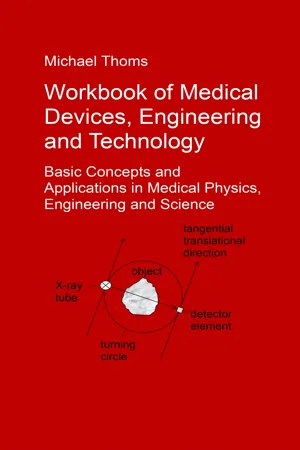![]()
1. X-rays
1.1 Attenuation of X-rays
1.1.1 Exercise: X-ray transmission of lead
What is the percentage of X-ray radiation that is transmitted through a lead sheet having a thickness of d = 1 mm at an X-ray energy of 50 keV?
1.1.2 Solution
X-rays of a specific X-ray energy are exponentially attenuated by uniform matter according to the law
with
x = penetration depth [cm],
µ = X-ray attenuation coefficient [1/cm] of the matter at the specific energy of the X-rays,
Do = incident dose,
D = dose at penetration depth x.
The X-ray attenuation coefficient is dependent on the energy E of the X-rays, the elemental composition of the material and the density ρ of the material. In this exercise the material is composed only of one element: Lead (Pb). In order to calculate the transmitted percentage of the dose D(x = d)/Do, the attenuation coefficient µ has to be known. Usually instead of the attenuation coefficient µ, the mass attenuation coefficient µ/ρ is tabulated, because the attenuation coefficient µ is proportional to the density ρ and thus the mass attenuation coefficient µ/ρ depends no longer on the density ρ. The mass attenuation coefficient µ/ρ can be found on the NIST web page
https://physics.nist.gov/PhysRefData/XrayMassCoef/ElemTab/z82.html. At an Xray energy of E = 50 keV, it has a value of 8.041 cm2/g. Using this value the attenuation coefficient can be calculated by the equation
The density of the lead sheet can also be found on the NIST web page https://physics.nist.gov/PhysRefData/XrayMassCoef/tab1.htmlto be ρ= 11.35 g/cm3. Now the exercise can be solved using the following Mathcad code
According to the calculation, the percentage of transmitted X-ray dose passing through a lead sheet with a thickness of d = 1 mm at an X-ray energy of 50 keV, is 0.011%. The X-ray rooms of dentists are often shielded with lead of this thickness to prevent the X-rays from harming people outside of the X-ray room.
1.1.3 Exercise: X-ray attenuation of silver bromide
What is the X-ray attenuation coefficient of silver bromide (AgBr) as it is used in X-ray films at an X-ray energy of 50 keV?
1.1.4 Solution
As in exercise 1.1.1 the mass attenuation coefficients µ/ρ of silver and bromine can be found on the NIST web pages https://physics.nist.gov/PhysRefData/XrayMassCoef/ElemTab/z47.html and https://physics.nist.gov/PhysRefData/XrayMassCoef/ElemTab/z35.html. At an X- ray energy of E = 50 keV, they have values of 9.444 cm2/g (Ag) and 4.264 cm2/g (Br). However, the attenuation coefficient µ of the compound AgBr is now made up by the attenuation coefficients µi of the two elementary constituents that are hereinafter numbered with index i
with
(µ/ρ)i = mass attenuation coefficient of the ith element in the compound, and ρi = density of the ith element in the compound.
The density ρi of the ith element in the compound can be calculated by the density ρ of the compound, which is 6.47 g/cm3 for AgBr, and the atomic masses Ai of the elements by
Here Ages is the atomic mass of the compound, and the atomic masses Ai of silver (Ag) and bromine (Br) are 107.8682 and 79.904 unified atomic mass units.
Taking the equations above, we can calculate the attenuation coefficient of the mixed compound by
With the following Mathcad code we compute an attenuation coefficient of AgBr of µ = 46.841/cm at an X-ray energy of 50 keV.
It is interesting to compare the result with the published data on X-ray films. Using the values for the mass attenuation and the density of photographic emulsion (standard nuclear) of 6.042 cm2/g and 3.815 g/cm3, given at the web pages https://physics.nist.gov/PhysRefData/XrayMassCoef/ComTab/photoemul.html and https://physics.nist.gov/PhysRefData/XrayMassCoef/tab2.html, we calculate for this emulsion an attenuation coefficient of 23.05/cm at 50keV. Since the dominating compound in th...







